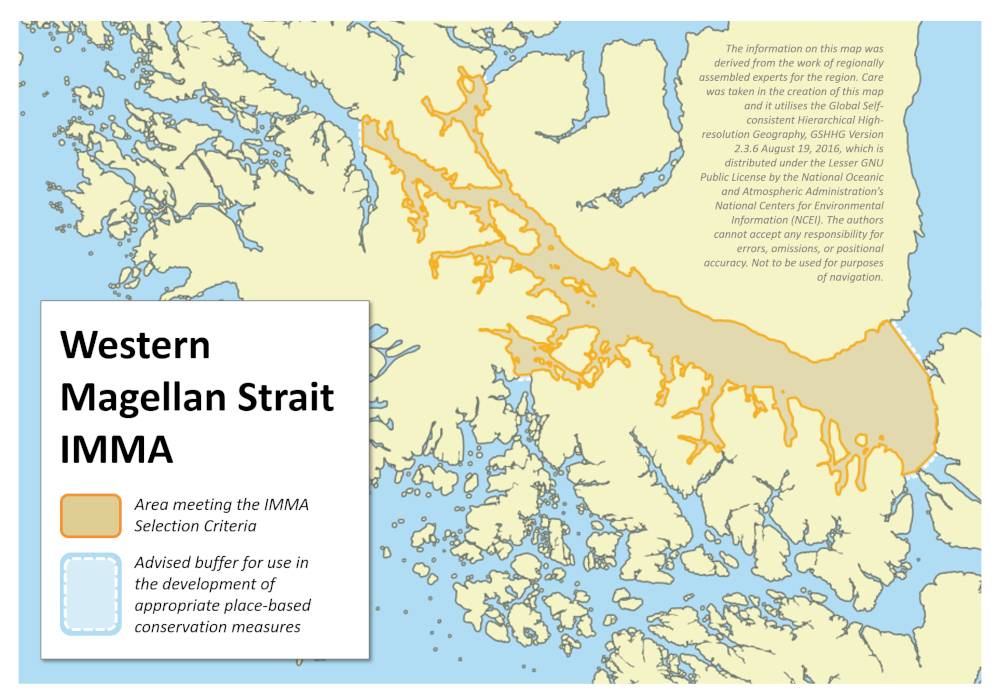Western Magellan Strait IMMA
Size in Square Kilometres
2 262 km2
Qualifying Species and Criteria
Humpback whale – Megaptera novaeangliae australis
Criterion A; C (2)
Download fact sheet
Summary
The first MPA in Chile was declared in the Magellan Strait in 2003. Humpback whales (Megaptera novaeangliae australis) use the area to feed during the summer around Carlos III island, in the western portion of the Strait. This represents the only known regular non-Antarctic Southern Hemisphere feeding area. Humpback whales’ peak presence in this area is between December and March. They feed mostly on krill, lobster krill and Fuegian sprat. Migratory connections for these whales have been established with breeding areas from northern Peru up to Costa Rica. Whales return to this feeding area at a high rate, with 64% of the whales photo-identified in the area being resighted in more than one year. The humpback population in this area has grown at 2.31% per year, with an abundance estimate of 93 in 2016/2017. The Magellan Strait serves as a major shipping channel connecting the Pacific and Atlantic oceans.
Description of Qualifying Criteria
Criterion C: Key Life Cycle Activities
Sub-criterion C2: Feeding Areas
Humpback whales from the Southern Hemisphere (Megaptera novaeangliae australis) feed mostly in the Antarctic (Donovan 1991). However, a few locations have been identified outside Antarctic waters. These include northern areas of Chilean Patagonia, particularly at the Corcovado Gulf (Acevedo et al. 2013), and the Magellan Strait in southern Patagonia, where whales are regularly observed feeding (Gibbons et al. 2003). The whales mostly occur around Carlos III island in the western portion of the strait, with a peak in their presence there between December and March (Aguayo et al. 2007, Gibbons et al. 2003, Monnahan et al. 2019). The humpback whales feeding in this IMMA belong to what the International Whaling Commission refers to as breeding Stock G (IWC 1998).
This humpback whale population feeds mostly on krill (Euphausia lucens), lobster krill (Munida gregaria) and Fuegian sprat (Sprattus fueguensis) (Gibbons et al. 2003, Acevedo et al. 2011), with changes in the proportion of a given species being consumed probably linked to variations in availability or abundance of prey (Haro et al. 2016).
Migratory connections with breeding areas from northern Peru to Costa Rica have been identified (Acevedo et al. 2017). Individual humpback whales return to this feeding area at a high rate, with 64.0% of the whales photo-identified in the area being resighted in more than one year (Monnahan et al. 2019). The number of humpback whales using this area was estimated as 72 whales (CI: 67-80) in 2008/2009 and 93 (CI: 86-100) in 2016/2017, the annual population rate of increase has been 2.31% (CI: 2.08%-2.96%).
Supporting Information
Acevedo, J., Plana, J., Aguayo-Lobo, A. and Pastene, L. A. 2011. Surface feeding behavior of humpback whales in the Magellan Strait. Revista de Biología Marina y Oceanografía 46(3): 483-490.
Acevedo, J., Haro D, Dalla Rosa L, Aguayo-Lobo A and others (2013) Evidence of spatial structuring of eastern South Pacific humpback whale feeding grounds. Endang Species Res 22:33-38. https://doi.org/10.3354/esr00536
Acevedo J, Aguayo-Lobo A, Allen J, Botero-Acosta N, Capella J, Castro C, Dalla-Rosa L, Denkinger J, Félix F, Flórez-González L, Garita F, Guzmán HM, Haase B, Kaufman G, Llano M, Olavarría C, Pacheco AS, Plana J, Rasmussen K, Scheidat M, Secchi ER, Silva S, Stevick PT. 2017. Migratory preferences of humpback whales between feeding and breeding grounds in the eastern South Pacific. Marine Mammal Science 33(4): 1035-1052. DOI: 10.1111/mms.12423
Aguayo-Lobo, A., Acevedo, J. and Olave, C. 2006. Actualización de las bases para una estrategia para la conservación de mamíferos marinos en la región de Magallanes y Antártica Chilena. Informe Final. Fundación CEQUA.
Capella, J., Gibbons, J., Flórez-González, L., Llano, M., Valladares, C., Sabaj, V. and Vilina, Y. 2008. Migratory round-trip of individually identified humpback whales of the Strait of Magellan: clues on transit times and philopatry to destinations. Revista Chilean Historia Natural 81: 547-560.
Donovan, G. P. 1991. A review of IWC stock boundaries. Reports of the International Whaling Commission (Special Issue 13):39–68.
Gibbons, J., Gazitúa, F. and Venegas, C. 2000. Cetáceos en el Estrecho de Magallanes y Senos Otway, Skyring y Almirantazgo. Anales del Instituto de la Patagonia 28: 107-118.
Gibbons, J., Capella,J. and Valladares, C. 2003. Rediscovery of a humpback whale, Megaptera novaeangliae, feeding ground in the Straits of Magellan, Chile. Journal of Cetacean Research and Management 5(2): 203-208.
Haro, D., Riccialdelli, L., Acevedo, J., Aguayo-Lobo, A. and Montiel, A. 2016.Trophic Ecology of Humpback Whales (Megaptera novaeangliae) in the Magellan Strait as Indicated by Carbon and Nitrogen Stable Isotopes. Aquatic Mammals 42(2): 233-244. Available as DOI 10.1578/AM.42.2.2016.233
IWC. 1998. Report of the Scientific Committee, AnnexG. Report of the sub-committee on the comprehensive assessment of southern hemisphere humpback whales. Report of the International Whaling Commission 248:170–182
Monnahan, C.C., Acevedo, J., Noble-Hendrix, A., Gende, S., Aguayo-Lobo, A. and Martinez, F. 2019. Population trends for humpback whales (Megaptera novaeangliae) foraging in the Francisco Coloane coastal-marine protected area, Magellan Strait, Chile. Marine Mammal Science 35: 1212-1231. Available at: DOI: 10.1111/mms.12582


